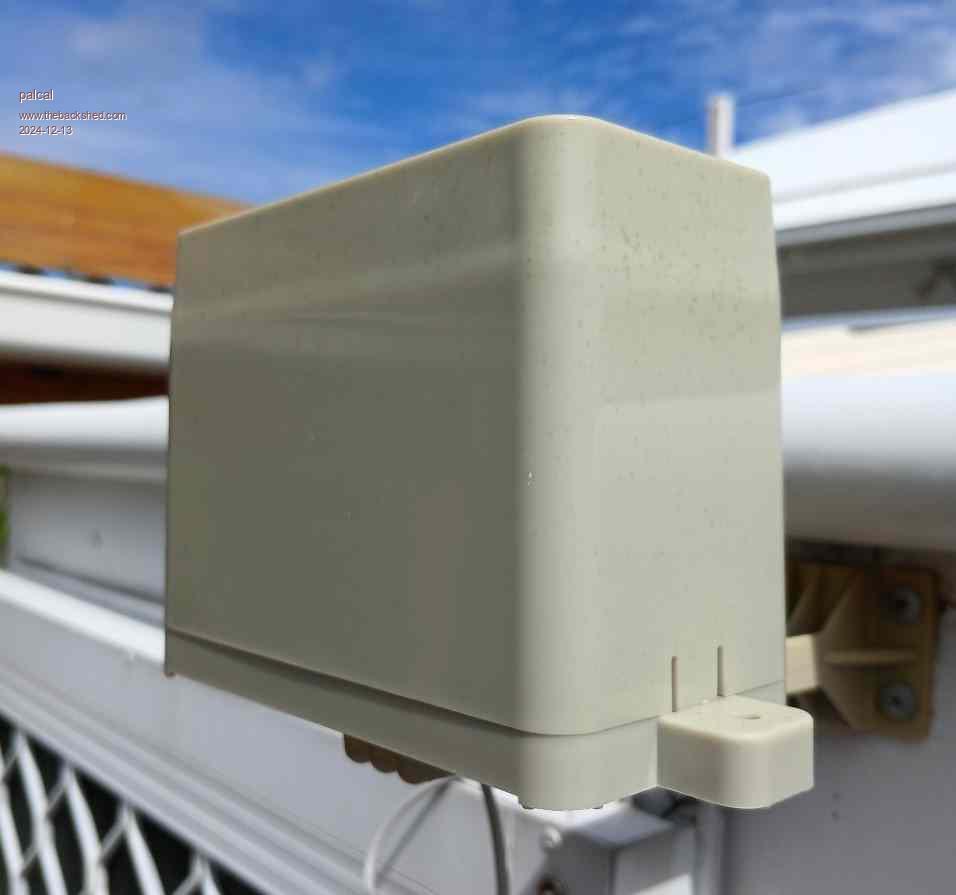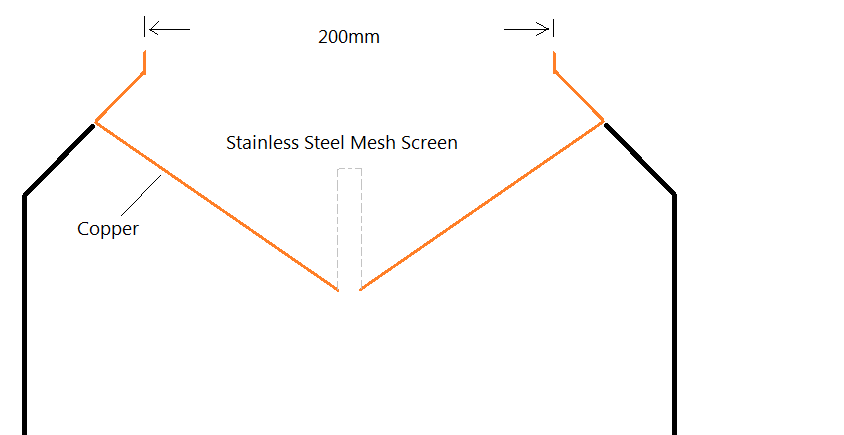
|

|
Forum Index : Microcontroller and PC projects : Rain Gauge
| Author | Message | ||||
palcal Guru Joined: 12/10/2011 Location: AustraliaPosts: 1989 |
Any one using one of these rain gauges ? Could you tell me what calibration value you use. I set this up some time ago but haven't had much rain till now. I was using 0.31mm per tip but it read 59mm for 52mm of rain so I figure the correct value to be more like .27mm per tip. Edited 2024-12-13 15:02 by palcal "It is better to be ignorant and ask a stupid question than to be plain Stupid and not ask at all" |
||||
palcal Guru Joined: 12/10/2011 Location: AustraliaPosts: 1989 |
Oops the picture did not load. Tried again but it won't upload. "It is better to be ignorant and ask a stupid question than to be plain Stupid and not ask at all" |
||||
palcal Guru Joined: 12/10/2011 Location: AustraliaPosts: 1989 |
 "It is better to be ignorant and ask a stupid question than to be plain Stupid and not ask at all" |
||||
Chopperp Guru Joined: 03/01/2018 Location: AustraliaPosts: 1096 |
What I did with an old DSE one I have was to get a parallel sided tin with the same diameter as the opening (100mm), filled it to a known depth say 20mm & gently poured the contents slowly into the gauge to see what it read. (should read 20mm if calibrated correctly). Mine only had 1mm resolution with a 100mm opening at the top. I 3D printed a funnel with a 141mm diam opening (2 x the area) & sat that on top. Mine also has a mechanical screw adjustment in the tippers (buckets) & I was a able to get it to read 0.5mm each tip fairly accurately by adjusting that. A calibration figure should be able to be calculated if there is no mechanical adjustment. Hope this helps Brian Edit. Just saw your piccie. Bit slow typing. Probably not much help then... Edited 2024-12-13 15:27 by Chopperp ChopperP |
||||
palcal Guru Joined: 12/10/2011 Location: AustraliaPosts: 1989 |
I calculated the catching surface area of the rain gauge and did a similar thing with a known amount of water and that is where I got the figure of .31mm. but it doesn't seem to be accurate. "It is better to be ignorant and ask a stupid question than to be plain Stupid and not ask at all" |
||||
TassyJim Guru Joined: 07/08/2011 Location: AustraliaPosts: 6269 |
It looks like one I had. If so about .28mm is what I used. The best way to calibrate it is with a 'real' old fashioned one close by. Bunnings have a few to choose from. You will find that one will read higher when it's windy and the other one will like calm steady rain. I have 3 different gauges and they agree 'some of the time'. Spiders and Kookaburras can make life difficult. Jim VK7JH MMedit |
||||
palcal Guru Joined: 12/10/2011 Location: AustraliaPosts: 1989 |
Thanks Jim .28 sounds good I figured .273. I'm up in the tropics so it's going to start raining big soon. What electronic gauges are you using ? Edited 2024-12-13 18:35 by palcal "It is better to be ignorant and ask a stupid question than to be plain Stupid and not ask at all" |
||||
TassyJim Guru Joined: 07/08/2011 Location: AustraliaPosts: 6269 |
I have one cheap Holman weather station from bunnings One manual rain gauge with 4 inch collector. One similar tipping bucket similar to yours - now decommissioned to save me climbing a ladder to do maintenance. and my main weather station has a slightly larger bucket read by a picomite as a Davis Vantage pro emulation. I have a few old tipping buckets in the shed, all the worst for wear. Many years ago I made huge tipping buckets to measure the run-off from paddocks. They were galv iron and needed a couple of litres per tip. Jim VK7JH MMedit |
||||
| JanVolk Senior Member Joined: 28/01/2023 Location: NetherlandsPosts: 237 |
palcal, The rain gauge may contain a spoon that indicates the amount of water for a pulse at a certain weight. This can be determined with an injection syringe with ml or cc distribution. Fill the spoon drop by drop until it covers. Or an amount of water, for example 1 liter = 1 mm rain on 1 m2 and dose this very slowly and register the number of pulses and then 1000 / pulses = cc / pulse. The tipping point can be adjusted with a small screw and also take into account that when the spoon is folded over, there is no registration when pouring too quickly and that the spoon does not become too full and it overflows. Greetings, Jan. |
||||
bigmik Guru Joined: 20/06/2011 Location: AustraliaPosts: 2949 |
Hi Paul, All, I had a cheap unit that looked like your one that worked intermittently, with its own display. I was going to fit a mite to it but ended up with a commercial weather station that had temperature, humidity, anemometer, wind vane as well as rain gauge. I never hooked the new station up before I ripped the guts out and used just the anemometer, vane and rain features and bodged in a DHT22 and ds18B20 driven by a Pico sending via an HC12. The rain gauge was easy to calibrate compared to 2 Manual tube type gauges and worked out at 0.3mm per bucket tip. (It was after calibrating to 0.3mm/tip I found in the manual it stated that figure in the specs.) The anemometer was a different matter. I had hours of my wife driving whilst I hung out the car to work out how many RPM per km/hr and I can tell you it varied greatly, no doubt vortexes over the car body changed the readings. I ended up selecting a best fit and then adjusting a calibration value by comparing to the bureau of meteorology over several weeks. The weather vane was difficult as it uses two Hall effect sensors I was able to come up with algorithms to do 16 directions reliably some of the (32 directions) were not right but it was good enough for me. The biggest problem I have is spiders love to live in there, I last used peppermint oil over the insides and this works but it must have dried out and I need to evict them again as the rain sensor is once again playing up. If anyone has any ideas to keep the spiders out I would love the hear it. No other bugs seem to want to invade, just spiders. To summarise Paul, I suggest calibrating to a standard tube gauge for the rain. I have mine reading identical to the tube most days. (There is always an odd time they don’t agree to the mm but this is fairly uncommon. Regards, Mick. (Th big one) . Edited 2024-12-14 09:56 by bigmik Mick's uMite Stuff can be found >>> HERE (Kindly hosted by Dontronics) <<< |
||||
| Bill7300 Senior Member Joined: 05/08/2014 Location: AustraliaPosts: 159 |
Not only do spiders squat in these gauges but there is one particular species among the thousands here in Tasmania, the female of which is heavy enough to balance the tipping mechanism. Mine stopped reporting any rain during a wet day. On getting up on the roof to investigate, I found the mechanism sitting horizontal, with the spider in one "bucket" and the other full of water. The other issue with mine was that with any transmission I made on the 70cm amateur radio band, the unit would record half an inch of rain. Its still up on the roof but I lost patience with it many years ago. Bill |
||||
palcal Guru Joined: 12/10/2011 Location: AustraliaPosts: 1989 |
Thanks Mick, I'm just using the switch in the rain gauge to count on a Picomite. I had it calibrated ok to read the same as my tube gauge but recently we had 52mm. overnight and it read 59mm. I'll just calibrate to the tube gauge again. "It is better to be ignorant and ask a stupid question than to be plain Stupid and not ask at all" |
||||
| JanVolk Senior Member Joined: 28/01/2023 Location: NetherlandsPosts: 237 |
Mick, Place insect mesh above and below and possibly print a window with the 3D printer? This also prevents dirt and leaves from entering the hopper. Greetings, Jan. |
||||
TassyJim Guru Joined: 07/08/2011 Location: AustraliaPosts: 6269 |
I am not sure where you have the tube gauge but looking at the photo of the tipping bucket, you will get lots of splatter from the roof with heavy rain. That will give higher readings. I would wait for a range of comparisons before I re-calibrated. Jim VK7JH MMedit |
||||
| phil99 Guru Joined: 11/02/2018 Location: AustraliaPosts: 2611 |
Yarra Valley Water have an "official" gauge here on top of the Divide. It has a copper funnel to prevent gunk growing in it and a very fine stainless steel screen to keep everything, including spiders out of the works. The inverted lip is a splash catcher to minimize losses in heavy rain. The slope of the housing prevents rain splashing in. The vertical rim is fairly sharp to split large drops for maximum accuracy. It's a lot of trouble to go to given that, as observed by Jim, just a few tens of metres away the reading could be different.  At our fire station there is an automated weather station attached to the hose drying tower. The tower is an excellent roost for flocks of galahs, corellas and sulphur crested cockies so the rain gauge is almost useless. If there is stuff stuck in the buckets it reads too high, if the funnel is blocked, not at all. Cleaning isn't an option, its too high up and above a barbed wire anti-climbing fence. So we use an old fashioned manual gauge. Edited 2024-12-14 13:27 by phil99 |
||||
palcal Guru Joined: 12/10/2011 Location: AustraliaPosts: 1989 |
@ Jim, I moved the gauge this morning, higher up, on to the timber you can see top left of photo where it wont get any splash. I hadn't thought of the splash effect, I just moved it to what I thought was a better position. Edited 2024-12-14 14:37 by palcal "It is better to be ignorant and ask a stupid question than to be plain Stupid and not ask at all" |
||||
| GerryL Newbie Joined: 24/01/2019 Location: AustraliaPosts: 39 |
About a dozen years ago I purchased a metric ‘Rainwise’ brand rain gauge (USA manufacturer but had an Australian agent, meets NWS specification), this has an 8 inch throat and resolution of 0.2mm. I think I paid about $A130 delivered. Before installing I checked the calibration using a quantity of water equivalent to 50mm of rainfall and found it to be within 0.5mm. Considering the errors in my testing method would have been about this I considered it to be pretty accurate. In the dozen or so years its been in operation it has only stopped once, and that just needed an adjustment of the pendulum magnet to be closer to the read switch. We are currently having our 6th driest year on record so the gauge is certainly not getting much use this year. The gauge is in the most convenient location which may not be as per all requirements but it works well enough for me. The BOM site has some info on location and interference as does the NWS site. Gerry |
||||
| The Back Shed's forum code is written, and hosted, in Australia. | © JAQ Software 2025 |